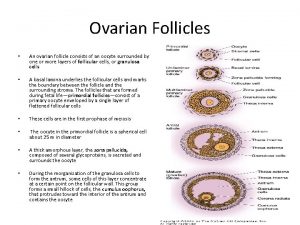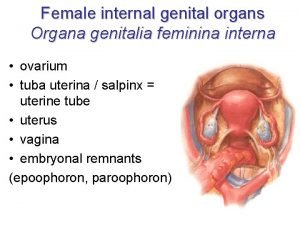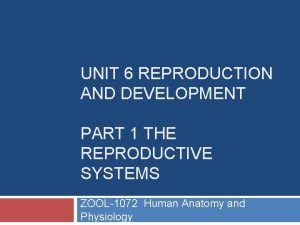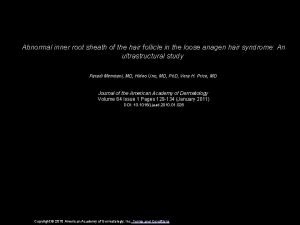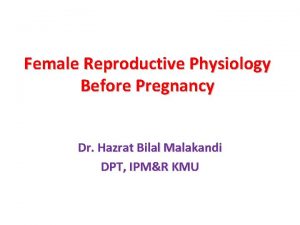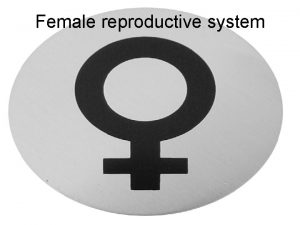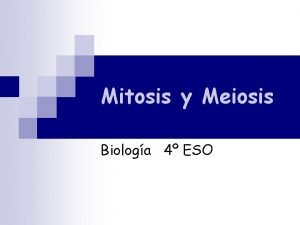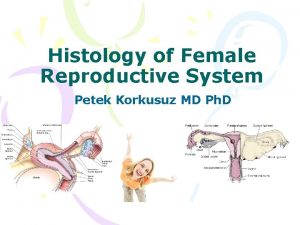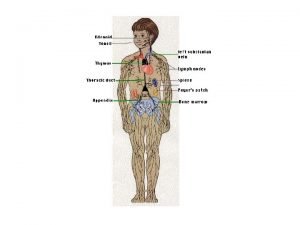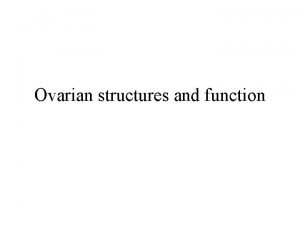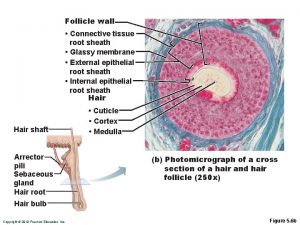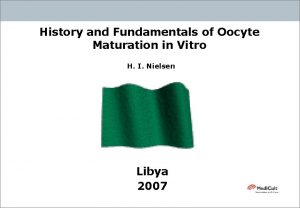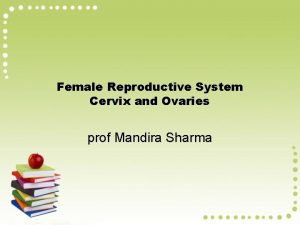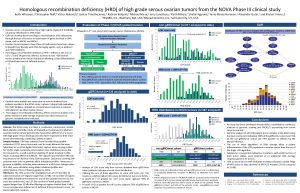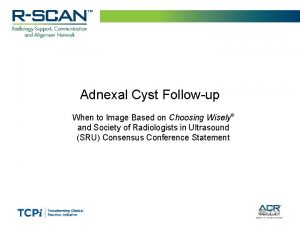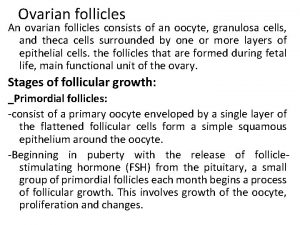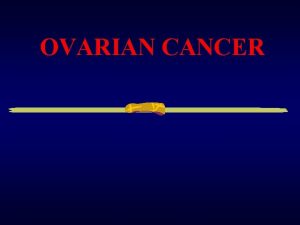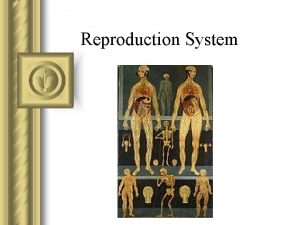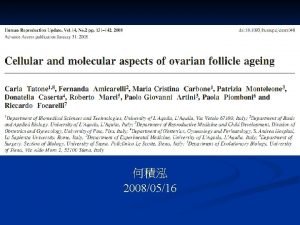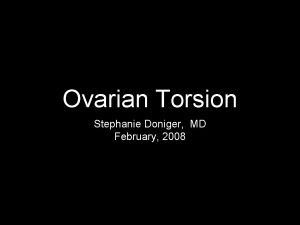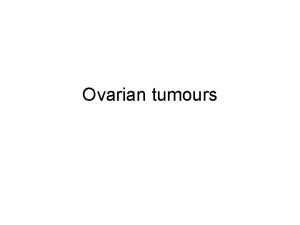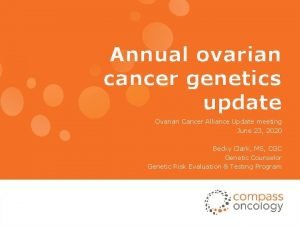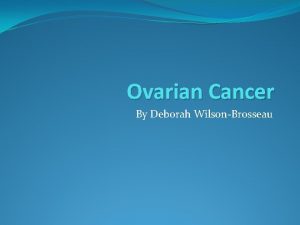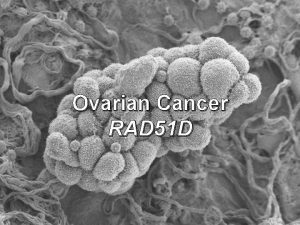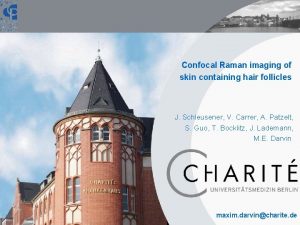Ovarian Follicles An ovarian follicle consists of an































- Slides: 31

Ovarian Follicles • An ovarian follicle consists of an oocyte surrounded by one or more layers of follicular cells, or granulosa cells • A basal lamina underlies the follicular cells and marks the boundary between the follicle and the surrounding stroma. The follicles that are formed during fetal life—primordial follicles—consist of a primary oocyte enveloped by a single layer of flattened follicular cells • These cells are in the first prophase of meiosis • The oocyte in the primordial follicle is a spherical cell about 25 m in diameter • A thick amorphous layer, the zona pellucida, composed of several glycoproteins, is secreted and surrounds the oocyte • During the reorganization of the granulosa cells to form the antrum, some cells of this layer concentrate at a certain point on the follicular wall. This group forms a small hillock of cells, the cumulus oophorus, that protrudes toward the interior of the antrum and contains the oocyte

• A group of granulosa cells concentrates around the oocyte and forms the corona radiata. These granulosa cells accompany the oocyte when it leaves the ovary. • As the follicles grow Liquid (liquor folliculi) begins to accumulate between the follicular cells. The small spaces that contain this fluid coalesce, and the granulosa cells reorganize themselves to form a larger cavity, the antrum • follicles are then called secondary or antral follicles • Follicular fluid contains components of the plasma and products secreted by follicular cells. Glycosaminoglycans, several proteins (including steroid-binding proteins), and high concentrations of steroids (progesterone, androgens, and estrogens) are present.

• While modifications are taking place in the oocyte and granulosa layer, the fibroblasts of the stroma immediately around the follicle differentiate to form theca folliculi • This layer subsequently differentiates into theca interna and theca externa • The cells of theca interna, when completely differentiated, acquire the ultrastructural characteristics of cells that produce steroids • . These cells are known to synthesize a steroid hormone—androstenedione— that is transported to the granulosa layer. • The cells of the granulosa, under the influence of follicle-stimulating hormone, synthesize an enzyme, aromatase, that transforms androstenedione into estrogen

Follicular Atresia • Most ovarian follicles undergo atresia, in which follicular cells and oocytes die and are disposed of by phagocytic cells • Follicles at any stage of development (primordial, primary, preantral, and antral) may undergo atresia • This process is characterized by cessation of mitosis in the granulosa cells, detachment of granulosa cells from the basal lamina, and death of the oocyte and granulosa cells. • Although follicular atresia takes place from before birth until a few years after menopause, there are times at which it is particularly intense • Atresia is greatly accentuated just after birth, when the effect of maternal hormones ceases, and during puberty and pregnancy, when marked qualitative and quantitative hormonal modifications take place.

Interstitial Cells • Although granulosa cells and the oocytes undergo degeneration during follicular atresia, theca interna cells frequently persist in isolation or in small groups throughout the cortical stroma and are called interstitial cells • Present from childhood through menopause, interstitial cells are active steroid secretors, stimulated by LH

Ovarian Cycle • At puberty, the female begins to undergo regular monthly cycles. • These sexual cycles are controlled by the hypothalamus. Gonadotropin-releasing hormone (Gn. RH) produced by the hypothalamus acts on cells of the anterior pituitary gland, which in turn secrete Gonadotropins • These hormones, folliclestimulating hormone (FSH) and luteinizing hormone (LH), stimulate and control cyclic changes in the ovary.

• At the beginning of each ovarian cycle, 15 to 20 primary (preantral) stage follicles are stimulated to grow under the influence of FSH. • Thus, FSH rescues 15 to 20 of these cells from a pool of continuously forming primary follicles • Under normal conditions, only one of these follicles reaches full maturity, and only one oocyte is discharged; the others degenerate and become atretic. • In the next cycle, another group of primary follicles is recruited, and again, only one follicle reaches maturity • Consequently, most follicles degenerate without ever reaching full maturity.

• When a follicle becomes atretic, the oocyte and surrounding follicular cells degenerate and are replaced by connective tissue, forming a corpus atreticum. • FSH also stimulates maturation of follicular (granulosa) cells surrounding the oocyte. • proliferation of these cells is mediated by growth differentiation a member of the transforming growth factor-β (TGF-β) family.

• In cooperation, granulosa and thecal cells produce estrogens that • (a) cause the uterine endometrium to enter the follicular or proliferative phase; • b) cause thinning of the cervical mucus to allow passage of sperm • (c) stimulate the pituitary gland to secrete LH.

• At mid-cycle, there is an LH surge that • a) elevates concentrations of maturation-promoting factor, causing oocytes to complete meiosis I and initiate meiosis II; • b) stimulates production of progesterone by follicular stromal cells (luteinization); • (c) causes follicular rupture and ovulation.

OVULATION • In the days immediately preceding ovulation, under the influence of FSH and LH, the secondary follicle grows rapidly to a diameter of 25 mm. • Coincident with final development of the secondary follicle, there is an abrupt increase in LH that causes the primary oocyte to complete meiosis I and the follicle to enter the preovulatory stage • Meiosis II is also initiated, but the oocyte is arrested in metaphase approximately 3 hours before ovulation.

• In the meantime, the surface of the ovary begins to bulge locally, and at the apex, an avascular spot, the stigma, appears. • The high concentration of LH increases collagenase activity, resulting in digestion of collagen fibers surrounding the follicle

• Prostaglandin levels also increase in response to the LH surge and cause local muscular contractions in the ovarian wall • Those contractions extrude the oocyte, which together with its surrounding granulosa cells from the region of the cumulus oophorus, breaks free (ovulation) and floats out of the ovary • Some of the cumulus oophorus cells then rearrange themselves around the zona pellucida to form the corona radiata

CORPUS LUTEUM • After ovulation, granulosa cells remaining in the wall of the ruptured follicle, together with cells from theca interna, are vascularized by surrounding vessels. • Under the influence of LH, these cells develop a yellowish pigment and change into lutean cells, which form the corpus luteum and secrete the hormone progesterone • Progesterone, together with estrogenic hormones, causes the uterine mucosa to enter the progestational or secretory stage in preparation for implantation of the embryo.

CORPUS ALBICANS • If fertilization does not occur, the corpus luteum reaches maximum development approximately 9 days after ovulation. • It can easily be recognized as a yellowish projection on the surface of the ovary • the corpus luteum shrinks because of degeneration of lutean cells and forms a mass of fibrotic scar tissue, the corpus albicans.

• Simultaneously, progesterone production decreases, precipitating menstrual bleeding. • If the oocyte is fertilized, degeneration of the corpus luteum is prevented by human chorionic gonadotropin (h. CG) • a hormone secreted by the syncytiotrophoblast of the developing embryo. • The corpus luteum continues to grow and forms the corpus luteum of pregnancy (corpus luteum graviditatis). • By the end of the third month, this structure may be one-third to one-half of the total size of the ovary.

• Yellowish luteal cells continue to secrete progesterone until the end of the fourth month; • they regress slowly as secretion of progesterone by the trophoblastic component of the placenta • Removal of the corpus luteum of pregnancy before the fourth month usually leads to abortion.

Uterus at Time of Implantation

• The wall of the uterus consists of three layers: • (a) endometrium or mucosa lining the inside wall; • (b) myometrium, a thick layer of smooth muscle; • (c) perimetrium, the peritoneal covering lining the outside wall

Endometrium • The endometrium consists of epithelium and a lamina propria containing simple tubular glands that sometimes branch in their deeper portions • Its covering epithelial cells are a mixture of ciliated and secretory simple columnar cells • The endometrial layer can be subdivided into two zones: • (1) The basalis is the deepest one, adjacent to the myometrium; it contains lamina propria and the closed tips of the uterine glands • 2) The functionalis contains the remainder of the lamina propria and the glands, as well as the surface epithelium • Whereas the functionalis undergoes profound changes during the menstrual cycles, the basalis remains mostly unchanged. • Arcuate arteries are circumferentially oriented in the middle layers of the myometrium. From these vessels, two sets of arteries arise to supply blood to the endometrium: straight arteries, which supply the basalis, and spiral arteries, which bring blood to the functionalis.

• At the time of implantation, the mucosa of the uterus is in the secretory phase • during which time uterine glands and arteries become coiled and the tissue becomes succulent. • As a result, three distinct layers can be recognized in the endometrium: • a superficial compact layer, an intermediate spongy layer, and a thin basal layer • Normally, the human blastocyst implants in the endometrium along the anterior or posterior wall of the body of the uterus • where it becomes embedded between the openings of the glands

The Menstrual Cycle • Estrogens and progesterone control the organs of the female reproductive system. • The proliferation and the differentiation of epithelial cells and the associated connective tissues depend on these hormones • After menopause, the diminished synthesis of these hormones causes a general involution of the reproductive organs. • After puberty, the ovarian hormones, under the stimulus of the anterior lobe of the pituitary, cause the endometrium to undergo cyclic structural modifications during the menstrual cycle • The duration of the menstrual cycle is variable but averages 28 days.

• Menstrual cycles usually start between 12 and 15 years of age and continue until about age 45– 50 years • the female is fertile only during the years when she is having menstrual cycles • the beginning of the menstrual cycle is taken as the day when menstrual bleeding appears. The menstrual discharge consists of degenerating endometrium mixed with blood from the ruptured blood vessels • The menstrual phase lasts 3– 4 days on average • The next phases of the menstrual cycle are called the proliferative and secretory (or luteal) phases. • The duration of the proliferative phase is variable, 10 days on average The secretory phase begins at ovulation and lasts about 14 days.

The Proliferative, Follicular, or Estrogenic Phase • After the menstrual phase, the uterine mucosa is relatively thin (about 0. 5 mm). • The beginning of the proliferative phase coincides with the rapid growth of a small group of ovarian follicles that, when the cycle began, was probably at the transition from preantral to antral follicles. • Estrogens act on the endometrium, inducing cell proliferation and reconstituting the endometrium lost during menstruation. (Estrogen also acts on other parts of the reproductive system, eg, inducing the production of cilia by epithelial cells of the oviduct. ) • During the proliferative phase, the endometrium is covered by a simple columnar epithelium. The glands, formed by simple columnar epithelial cells, are straight tubules with narrow lumens • At the end of the proliferative phase, the endometrium is 2– 3 mm thick.

The Secretory, or Luteal, Phase • The secretory phase starts after ovulation and results from the action of progesterone secreted by the corpus luteum • Acting on glands already developed by the action of estrogen, progesterone further stimulates the gland cells. • The epithelial cells begin to accumulate glycogen below their nuclei • glycoprotein secretory products dilate the lumens of the glands • One important feature of this phase is that the glands become highly coiled • In this phase, the endometrium reaches its maximum thickness (5 mm) as a result of the accumulation of secretions and of edema in the stroma • Mitoses are rare during the secretory phase.

• If fertilization has taken place, the embryo has been transported to the uterus and attaches to the uterine epithelium during the secretory stage, around 7 or 8 days after ovulation • It is thought that the secretion of the glands is the major source of embryonic nutrition before embryo implantation.

The Menstrual Phase • When fertilization of the oocyte and embryo implantation do not occur and the corpus luteum ceases functioning, the consequent rapid decrease of blood levels of progesterone and estrogens causes menstruation • Several factors are involved in the shedding of the endometrium, such as cycles of contraction and relaxation of the spiral arteries, activation (by lack of progesterone) of locally produced matrix metalloproteinases, and local release of prostaglandins, cytokines, and nitric oxide • These factors lead to breakdown of blood vessel walls and basement membranes as well as collagen of the endometrial lamina propria • At the end of the menstrual phase, the endometrium is usually reduced to a thin layer of lamina propria, the blind ends of uterine glands (both of which present in the basalis layer)

• During the following 3 or 4 days, the compact and spongy layers are expelled from the uterus, and the basal layer is the only part of the endometrium that is retained • This layer, which is supplied by its own arteries, the basal arteries, • functions as the regenerative layer in the rebuilding of glands and arteries in the proliferative phase

Summary of Events of the Menstrual Cycle • • • Stage of Cycle: Proliferative: Main actions of pituitary hormones Follicle-stimulating hormone stimulates rapid growth of ovarian follicles. • Main events in the ovary Growth of ovarian follicles; dominant follicle reaches preovulatory stage. • Dominant ovarian hormone Estrogens, produced by the growing follicles, act on vagina, tubes, and uterus. • Main events in the endometrium Growth of the mucosa after menstruation.

Summary of Events of the Menstrual Cycle • • • Stage of Cycle: Secretory or Luteal Main actions of pituitary hormones Peak of luteinizing hormone at the beginning of the secretory stage, secreted by stimulation of estrogen, induces ovulation and development of the corpus luteum. • Main events in the ovary Ovulation. Development of the corpus luteum. Degeneration of the corpus luteum. • Dominant ovarian hormone Progesterone, produced by the corpus luteum, acts mainly on the uterus. • Main events in the endometrium Further growth of the mucosa, coiling of glands, secretion.

Summary of Events of the Menstrual Cycle • Stage of Cycle: • Menstrual • Dominant ovarian hormone Progesterone production ceases. • Main events in the endometrium Shedding of part of the mucosa about 14 days after ovulation.
 Ovarian follicle
Ovarian follicle Follicular development diagram
Follicular development diagram Margo liber
Margo liber Secondary oocyte
Secondary oocyte Secondary oocyte and ovum
Secondary oocyte and ovum Hair follicle definition forensics
Hair follicle definition forensics Draw a labelled diagram of a graafian follicle
Draw a labelled diagram of a graafian follicle Ovary diagram
Ovary diagram Normal antral follicle count by age
Normal antral follicle count by age Dotacion cromosomica de las celulas hijas en la meiosis
Dotacion cromosomica de las celulas hijas en la meiosis Hair follicle
Hair follicle Follicular adenoma
Follicular adenoma Ducts in female reproductive system
Ducts in female reproductive system Hair follicle histology
Hair follicle histology English
English Lymphoid tissue in colon
Lymphoid tissue in colon Dominant follicle size
Dominant follicle size The reason the hypodermis acts as a shock absorber is that
The reason the hypodermis acts as a shock absorber is that The skin diagram labeled
The skin diagram labeled Quizlet
Quizlet Glassy membrane histology
Glassy membrane histology Follicle atresia
Follicle atresia Cementogenesis
Cementogenesis Bell stage of tooth development
Bell stage of tooth development Telogen phase definition forensics
Telogen phase definition forensics Lutalphase
Lutalphase Ovarian benign tumor
Ovarian benign tumor Ovarian cyst
Ovarian cyst Chapter 16 the reproductive system
Chapter 16 the reproductive system Hrd score ovarian cancer
Hrd score ovarian cancer Accessory structures of female reproductive system
Accessory structures of female reproductive system Sru consensus ovarian cysts
Sru consensus ovarian cysts
